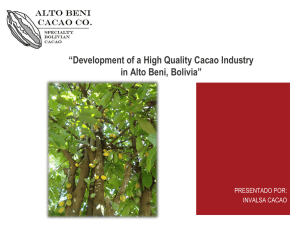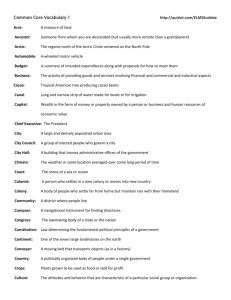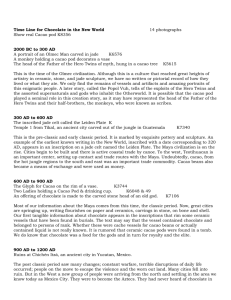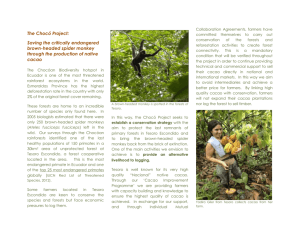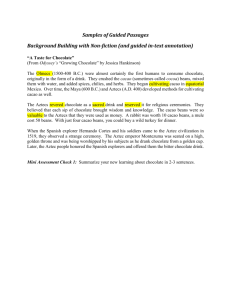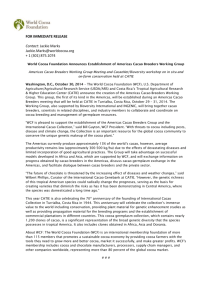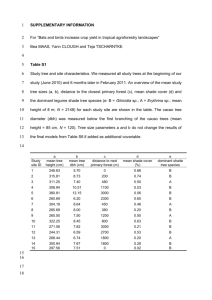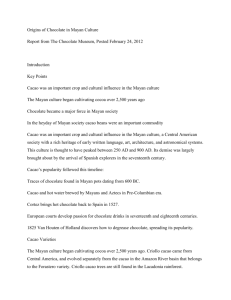Example of annotated bibliography
advertisement
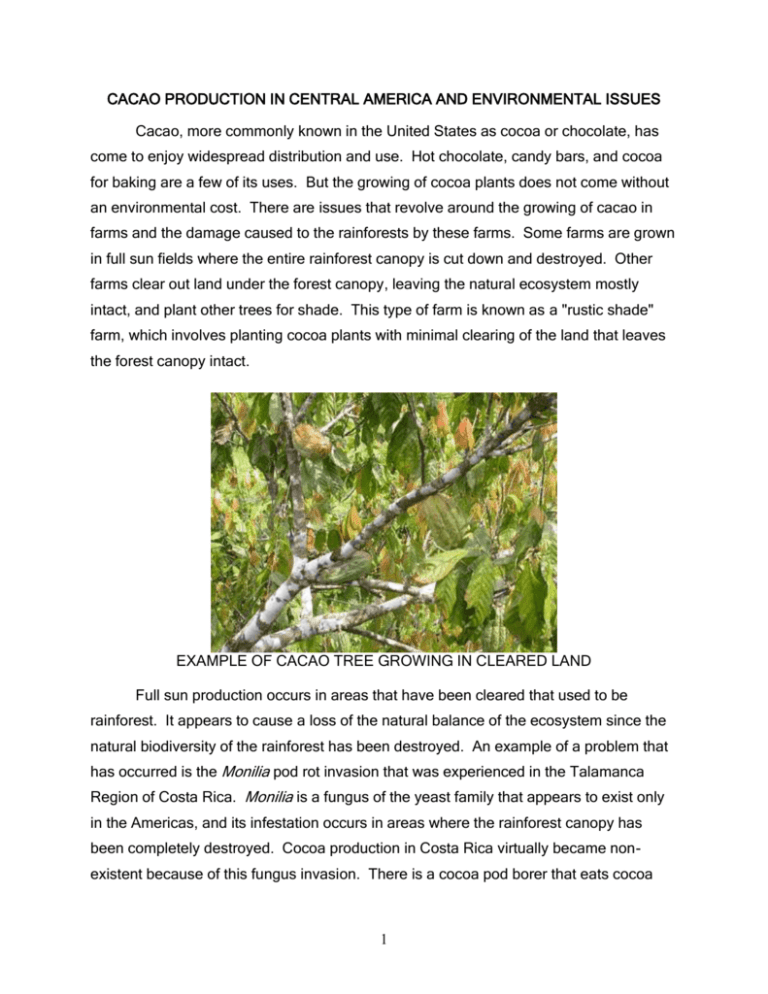
CACAO PRODUCTION IN CENTRAL AMERICA AND ENVIRONMENTAL ISSUES Cacao, more commonly known in the United States as cocoa or chocolate, has come to enjoy widespread distribution and use. Hot chocolate, candy bars, and cocoa for baking are a few of its uses. But the growing of cocoa plants does not come without an environmental cost. There are issues that revolve around the growing of cacao in farms and the damage caused to the rainforests by these farms. Some farms are grown in full sun fields where the entire rainforest canopy is cut down and destroyed. Other farms clear out land under the forest canopy, leaving the natural ecosystem mostly intact, and plant other trees for shade. This type of farm is known as a "rustic shade" farm, which involves planting cocoa plants with minimal clearing of the land that leaves the forest canopy intact. EXAMPLE OF CACAO TREE GROWING IN CLEARED LAND Full sun production occurs in areas that have been cleared that used to be rainforest. It appears to cause a loss of the natural balance of the ecosystem since the natural biodiversity of the rainforest has been destroyed. An example of a problem that has occurred is the Monilia pod rot invasion that was experienced in the Talamanca Region of Costa Rica. Monilia is a fungus of the yeast family that appears to exist only in the Americas, and its infestation occurs in areas where the rainforest canopy has been completely destroyed. Cocoa production in Costa Rica virtually became nonexistent because of this fungus invasion. There is a cocoa pod borer that eats cocoa 1 pods, and plants in direct sunlight become the victim of vascular streak dieback. Below is a map of the Talamanca region. Full sun production also damages the soil, resulting in a loss of topsoil and soil fertility. As forests are thinned or even cut down, a loss of species diversity occurs, particularly among ephyphytes. The destruction of ephyphytes causes further damage because the habitat for growth is gone. This bibliography will explore the different types of cocoa production that occur in Central America. It will also look at the different agricultural problems. My research question is “Can cacao production can be a sustainable commercial agriculture system in the rainforests of Central America without causing the destruction of rainforest habitat and its associated diverse species of plants, animals, insects, bird, etc? -2- Map Showing Regions of Cacao Farms (Cacao Fun website) Rice, Robert A. and Greenberg, Russell (May 2000). Cacao Cultivation and the Conservation of Biological Diversity. Royal Swedish Academy of Sciences 2000, Ambio, Vol. 29 No. 3, May 2000 Robert Rice, who is a geographer and policy researcher for the Smithsonian Migratory Bird Center in Washington, D.C. and Russell Greenberg, who is the director of the same organization, have assembled data from 67 different sources to address the problem of maintaining biological diversity during cacao production. He discusses the pros and cons of agroforestry versus farms that produce cacao with little shade or full sun. Agroforestry is a practice whereby cacao is grown under the canopy of the rainforest. Although some of the rainforest flora and fauna is removed, enough exists -3- for there to not be a complete destruction of the rainforest. As a contrast, little or full sun production clears out the rainforest completely and cacao is planted in a field that has been tilled for growing plants. Rice et al. indicate that biodiversity is preserved when agroforestry, or rustic farming, is practiced, which is an advantage to the rainforest and also to the growth of cacao. With agroforestry, natural predators and resistance to invasive entities, such as yeasts, are controlled because the natural environment still exists to fight undesirable entities, such as the deadly yeast Monilia. The article also acknowledges that rustic farming does not completely preserve the rainforest and cites as examples missing lizards in Costa Rican rustic plantations and less numbers of larger terrestrial mammals and primates in Brazil (Rice et al., p. 168). Rice et al. also discuss the value of rustic plantations in helping to prevent soil erosion. Also, because the trees are preserved, leafs fall, break down, and are absorbed into the soil, allowing for natural fertilization to take place. Shade reduces dependence on chemicals (Rice et al. p. 172). A hypothesis called the “enemies hypothesis” (Rice p. 172) has been formed that says that “organisms are less likely to reach pest or epidemic proportions in the presence of more complex predator assemblages (Rice p. 172).” This interesting hypothesis needs further investigation. This article is relevant to the issue at hand because it focuses on the advantages of rustic plantations and points out the disadvantages of full sun production. Not only is it devastating to the rainforests, but topsoil is lost and funghi and other pests can destroy the plantations, which ultimately leads to the destruction of the plantation. No sustainability of farms is achieved without the development and maintenance of rustic plantations. -4- Slingerland, Maja and Gonzalez, Enrique Diaz. Organic Cacao Chain for Development: The case of the Talamanca Small-Farmers Association. 2006 Springer. Printed in the Netherlands, pp. 165-177. The authors of this article focus on the organic production of cacao in the Talamanca region and the efforts involved to ensure continuing purchasers for the organic cacao. The price of non-organic cacao has risen a great deal which has tempted Costa Rican farmers to change their crops to non-organic cacao since they can still realize a great return. In addition, due to the high price of cacao, buyers of organic cacao have fallen. Other regions of the world, including Vietnam and Africa, have begun growing organic cacao, so the world supply has increased, which means the price drops. The Talamanca Small-Farmers Association (APPTA) has been working to keep organic cacao development in the Costa Rican Talamanca region. Cacao production reached its peak in Costa Rica in the 1920s (Slingerland et al. p. 166). In the late 1970s, Monilia attacked the Costa Rican cacao production and it dropped to zero. In the 1990s, APPTA invested in the region and promoted the revival of organic cacao plantations. They focused the plantations on organic and sustainable growth. Organic cacao production in Costa Rica was combined with Panama so that the growers could meet buyers’ needs. The organic cacao production has been extremely beneficial to the Talamanca farmers because the Talamanca is one of the poorest regions in Costa Rica. Organic cacao and organic banana production was combined to ensure the farmers year-round crops. The main problem with the organic production is that yields are low (150 kg per ha) (Slingerland et al. p. 172). However, it is important to continue to grow organic and sustainable crops in the Talamanca on rustic plantations and not allow clear cutting of forested areas to obtain more profit. “More than 90% of Costa Rican floral diversity is found in Talamanca, and so are 1000 of the 1300 fern species found in the whole country (Slingerland et al. p. 172).” Clearly, protection of the diversity of this area is important. This article is important to the issue of protection of the diversity of the rainforests because it points out the efforts being made by APPTA to support organic, sustainable, rustic plantation growth of cacao. Without these efforts, farmers might turn to old ways of destroying the forests and planting full sun, non-organic cacao to maximize profit -5- which will, in turn, lead to destruction of the tropical biosphere and ultimately lead to problems similar to the Monilia invasion that developed in the 1970s. Greenberg, Russell. Biodiversity in the Cacao Agroecosystem: Shade Management and Landscape Considerations, last updated November 29, 2006 The author of this article focuses on the value of rustic plantations that focus on shade produced cacao, which then allows for the ability to grow cacao under the forest canopy. Although some of the forest is cleared and is no longer virgin forest, more indigenous life is preserved. He cites the discovery of the Pink-legged Graveteiro, a new species and genus of bird and the Golden-headed Lion Tamarin, as examples of the biodiversity that is supported by rustic, full shade plantations. Although the forest is “degraded,” it sill exists. The author also looks at species richness to look at the value of the rustic plantations. Although the number of specimens of a species may be decreased, greater diversity of species still exists in rustic plantation farming. Protection of microhabitats is also important. An example of a microhabitat he cites as being maintained with a rustic plantation is an “aerial leaf litter” which is a microhabitat on the leaves of canopy trees that is the only place certain arthropods can be found. The author recommends the following: (1) maintain diverse species; (2) leave buffer zones along streams and property boundaries; (3) leave epiphytes, lianas and parasitic plants in place; (4) keep dead wood; (5) retain some weeds; (6) encourage shade grown cacao; and (6) try to grow cacao plants in regions without protected forests (Greenberg p. 10). Taking these steps can protect the rainforest as much as possible, while allowing for reasonable commercial crops. This article is important to the issue because it outlines concrete ways to allow for cacao plantations to be successful in a sustainable way. Although it does not focus on organic cacao, the intent of the article is to allow for cacao production and protection of rainforest biodiversity as much as possible. He also raises an interesting point by saying that cacao plantations should be developed where the forest areas have been the most modified, which will thus mean less impact. -6- Newmark, Tammy. Carbon Sequestration and Cocoa Production: Financing Sustainable Development by Trading Carbon Emission Credits, http://nationalzoo.si.edu/ConservationAndScience/MigratoryBirds/Research/Cac ao/newmark.cfm, last updated November 29, 2006 The author of this article supports the idea of using carbon emission credits to support the efforts of low-income farmers who engage in sustainable, shade plantation growth of cacao. Since forests “store carbon at a rate 20 to 100 times more per hectare than pastures and croplands (Newmark p. 1), the more trees left in place, the more valuable the land becomes in terms of carbon emission credits. Carbon emission credits allow for companies or countries that have high greenhouse gas emissions to pay entities that do not have high greenhouse gas emissions for their “carbon credits,” thus allowing the companies or countries to continue in their current business practices, but at the cost of providing income to others. The carbon credits are capped so they don’t increase. Rustic cacao plantations are encouraged by the carbon emission credits system. The more a farmer preserves the natural trees, the more valuable their land is in terms of carbon credits. This article is relevant to the commercial viability of cacao production because it provides a vehicle for income to be realized by the cacao farmers while preserving the biological diversity of the rainforests. In fact, is also encourages the replanting of trees. Parrish, Jeffrey. Cacao as Crop and Conservation tool, http://nationalzoo.si.edu/ConservationAndScience/MigratoryBirds/Research/Cac ao/parrish.cfm, November 12, 2006 This author points out the value of cacao plantations, when they are of the rustic variety and include shade-grown crops, in the preservation of rainforests. The plantations, although they do thin out some of the flora and fauna of the forest floor, function as a buffer zone between the rainforest and the encroaching cleared land. At the plantation border, the clear-cutting of land decreases, and the cacao plantation allows for the gradual transition from clear-cut land to the full rainforest and thus protects rainforest species from the damages caused by clear cutting, or slash and burn farming. -7- The author points out the value of the Talamanca region. It has a large number of “threatened animals and plants, including 59 mammal species, 43 amphibians, 51 reptiles, and over 350 birds (Parrish p. 4).” The last indigenous cultures of the country live here, representing 1% of the Costa Rican population. Some of these people are known as the Kekoldi. These people engage in the growing of longstanding traditional crops such as corn rice, beans, cacao, and also engage in wild craft harvesting from the forest. Their growing of crops is steeped in long-standing tradition, and they are highly resistant to change. Cacao plantations, one of these crops, provide these people with a source of income. Efforts to protect these people and the diversity of the species has been undertaken by the APPTA. Picture of Native Woman demonstrating importance of cacao to indigenous people Another novel concept the author introduces, in addition to carbon credits, is payment for ecosystem services. The principle behind this payment is that forests have a measurable value to others. These values could include medicines, food, water, and air purity, to name a few. By engaging in shade-grown cacao production, farmers are -8- helping preserve natural resources that have a measurable value that has not yet been determined or completely acknowledged. This article points out the importance of cacao crops because they are a traditional crop grown by indigenous people, and the growth of cacao allows for income into the area. It also points out that not all the value of cacao plantations is realized just by the exchange of money in a commercial transaction. Rather, the value of the plantations extends to the protection of sustaining a way of life that has been existence for a long period of time. CONCLUSION Rustic cacao farms seem best because they provide habitat for biodiversity to thrive and are less intensively managed. Conditions in these rustic plantations are more similar to the conditions of natural forests so many species continue to thrive. Because these species survive, disease and pests are neutralized because they are controlled by natural predators, e.g., ants. In addition, the need to use fungicides and pesticides decreases, resulting in a more “organic” farm and less costs to produce the cacao. I believe that a combination of creative measures needs to be undertaken in order to support commercial cacao production in Central America, particularly in the Talamanca region of Costa Rica, and make it a viable financial effort. Farmers should be rewarded by higher prices for growing organic, sustainable cacao. Additional funds should be provided for shade grown crops, including carbon credits and financial incentives for the protection of rainforests that occurs when rustic cacao plantations are utilized. An additional concept discussed in a website I found (http://blastmagazine.com/2008/02/earthtalk-chocolate-land-trusts/) spoke of the value of government or entities purchasing land and then turning it into a protected area. Individuals will still farm the land, but will do so in a manner that preserves the biodiversity of the rainforest environment. Restrictions could include no logging, no clearing of land, etc. Cacao grows best in equatorial regions; thus, cacao plantations are in direct conflict with rainforests. But I believe that by providing several financial incentives to -9- shade-grown producers, such as those set forth above, farmers in the region can realize a reasonable income and at the same time protect some of nature’s most invaluable resources. I, for one, would like to continue to enjoy my chocolate but know that it is being farmed and processed without destroying rainforests and under conditions that provide farmers who act in an environmentally reasonable way with an income that allows them to enjoy their lives. - 10 - BIBLIOGRAPHY Chok, Deem. Cocoa Development & Its Environmental Dilemma, last updated November 29, 2006 Greenberg, Russell. Biodiversity in the Cacao Agroecosystem: Shade Management and Landscape Considerations, last updated November 29, 2006 http://www.sweetriot.com/cacaofun/cacao_map.php, 03/17/2008 Newmark, Tammy. Carbon Sequestration and Cocoa Production: Financing Sustainable Development by Trading Carbon Emission Credits, http://nationalzoo.si.edu/ConservationAndScience/MigratoryBirds/Research/Cac ao/newmark.cfm, last updated November 29, 2006 Parrish, Jeffrey. Cacao as Crop and Conservation tool, http://nationalzoo.si.edu/ConservationAndScience/MigratoryBirds/Research/Cac ao/parrish.cfm, November 12, 2006 Rice, Robert A. and Greenberg, Russell (May 2000). Cacao Cultivation and the Conservation of Biological Diversity. Royal Swedish Academy of Sciences 2000, Ambio, Vol. 29 No. 3, May 2000 Slingerland, Maja and Gonzalez, Enrique Diaz. Organic Cacao Chain for Development: The case of the Talamanca Small-Farmers Association. 2006 Springer. Printed in the Netherlands, pp. 165-177. Vlaun, Scott. Much with Little: A Central American Journey with Sustainable Harvest International By Scott Vlaun, February 19, 2004 http://www.oardc.ohio-state.edu/cocoa/monilia.htm - 11 -
